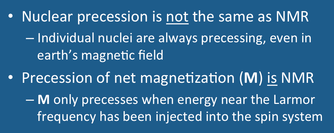No. Nuclear precession is a long-term, spontaneous phenomenon, unaccompanied by energy exchange. Nuclear resonance is a short-term, induced phenomenon, involving energy exchange between precessing spins and their environment.
Precession is experienced by all particles with non-zero spin when placed in a static external magnetic field. As the earth's magnetic field is "always on", nearly every magnetically receptive nucleus on earth, including hydrogen in every drop of water in the ocean, is at this moment quietly precessing away! I personally find this concept mind-boggling.
Precession is experienced by all particles with non-zero spin when placed in a static external magnetic field. As the earth's magnetic field is "always on", nearly every magnetically receptive nucleus on earth, including hydrogen in every drop of water in the ocean, is at this moment quietly precessing away! I personally find this concept mind-boggling.
|
The earth's magnetic field is very small (~50 μT) and so the resonance frequencies are likewise very low (just a little over 2000 Hz for hydrogen). MRI and MRS have both been performed using only the earth's magnetic field.
|
00:00 00:00 00:00 Click to hear the "music" of protons precessing due to the earth's magnetic field.
|
Resonance. Although hydrogen nuclei are always precessing, they are not constantly undergoing nuclear magnetic resonance (NMR). Resonance is a natural phenomenon characterized by an oscillating response over a narrow range of frequencies to the external input of energy. Whether they be mechanical or electromagnetic, all resonant systems are able to transfer energy between two or more different storage modes. However, slight energy losses always occur from cycle to cycle, so eventually the resonance dies out.
Magnetic resonance occurs when external energy is injected into a nuclear spin system near the Larmor (resonance) frequency. In both NMR and MRI, the primary source of energy input is from a rotating magnetic field (called B1) generated by passing alternating current through a nearby radiofrequency (RF) coil. The nuclear system absorbs this RF-energy by increasing the relative fraction of spins in higher-energy states. Some of the absorbed energy is transferred coherently (without energy loss) to other spins in the sample, thus sustaining the oscillation. Some of the absorbed energy, and eventually all of it, is dispersed by incoherent electromagnetic interactions with other spins or through molecular vibrations and collisions.
A potential point of confusion is that although precession of individual nuclei is not the same as nuclear resonance, precession of the net magnetization (M) is a manifestation of resonance. This is because M is not an individual spin but the sum of many. Macroscopic precession of M only occurs when the spin system is moved out its equilibrium condition by input of energy. As M returns to equilibrium through magnetic relaxation, this energy is transferred out of the spin system once again.
Magnetic resonance occurs when external energy is injected into a nuclear spin system near the Larmor (resonance) frequency. In both NMR and MRI, the primary source of energy input is from a rotating magnetic field (called B1) generated by passing alternating current through a nearby radiofrequency (RF) coil. The nuclear system absorbs this RF-energy by increasing the relative fraction of spins in higher-energy states. Some of the absorbed energy is transferred coherently (without energy loss) to other spins in the sample, thus sustaining the oscillation. Some of the absorbed energy, and eventually all of it, is dispersed by incoherent electromagnetic interactions with other spins or through molecular vibrations and collisions.
A potential point of confusion is that although precession of individual nuclei is not the same as nuclear resonance, precession of the net magnetization (M) is a manifestation of resonance. This is because M is not an individual spin but the sum of many. Macroscopic precession of M only occurs when the spin system is moved out its equilibrium condition by input of energy. As M returns to equilibrium through magnetic relaxation, this energy is transferred out of the spin system once again.
Advanced Discussion (show/hide)»
No supplementary material yet. Check back soon.
References
Mohoric A, Planinsic G, Kos M et al. Magnetic resonance imaging system based on earth's magnetic field. Instrum Sci Technol 2004;32(6):655-667
Mohoric A, Planinsic G, Kos M et al. Magnetic resonance imaging system based on earth's magnetic field. Instrum Sci Technol 2004;32(6):655-667
